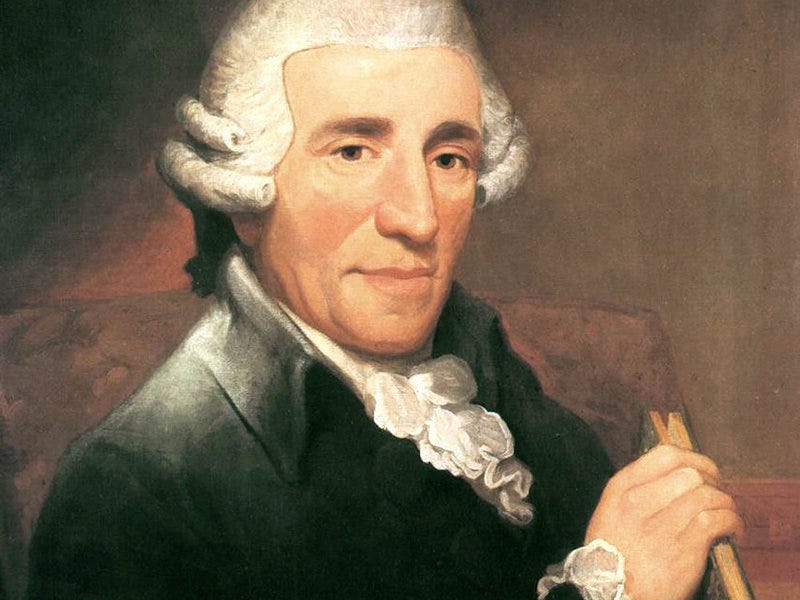
The Austrian composer, Franz Joseph Haydn, wrote at least 104 symphonies. And while all of them are worth a listen, if one has the time…hmmm…I’m going to point you to some of my favorites since it’s his birthday today.
Symphonies 6–8 represent the first symphonies that Haydn wrote for his new employer, Prince Paul Anton Esterházy. This appointment would last for the remainder of Haydn’s life, an astonishing 58 years, and through this court position as Kapellmeister, Haydn would prove to be one of the most prolific composers ever. Together, they are titled Die Tageszeiten in German, or Time of Day in English. Each one has its specific time of day: Symphony №6, Morning; Symphony №7, Noon; Symphony №8, Night. Here are some wonderful performances by the Freiburg Baroque Orchestra. And for those of you familiar with symphonies written by, say, Brahms, Tchaikovsky, or Mahler, Haydn’s symphonies at this time were approximately 20 minutes.
Symphony №6 Morning
Symphony №7 Noon
Symphony №8 Night
By 1764, Haydn had already written about twenty symphonies for the Esterházy court. His Symphony №22, subtitled The Philosopher, was written in this year and it is unique for a couple of reasons. It’s one of the first symphonies that begins with a slower movement than the typical fast, Allegro. And, it uses just two horns, two english horns (which are larger cousins to the oboe), strings, and harpsichord. This still the only symphony written with this orchestration. Here is a great performance filmed at Haydnsaal Schloss Esterházy, Eisenstadt, Austria, in 2015 with the Italian chamber music ensemble, Il Giardino Armonico, conducted by Giovanni Antonini.
Just a year later, in 1765, he was already writing his Symphony №31, subtitled the Hornsignal. You’ll see why in this wonderfully raucous recording by the Austrian group, Concentus Musicus Wien, conducted by Nikolaus Harnoncourt.
In his Symphony №45 Farewell, a honest-to-goodness story is behind this title. In the summer of 1772, the Esterházy court had stayed far longer at the prince’s summer palace, Esterháza, than planned. The musicians began complaining to their boss, Haydn, that they had been away from their families for far too long (they weren’t allowed to bring their families from Vienna to the summer residence). So, rather than appealing directly to the prince, Haydn decided to write the plea into this symphony. The final movement, which is a poignant slow adagio, each musician in the orchestra stood up, blew out their candle on their stand, and quietly left the stage…this is written into the music! The prince got the hint and they left the Esterháza the following day. Here’s a performance by Sinfonia Rotterdam conducted by Conrad van Alphen.
Now it’s going to get hard for to not recommend every darn one of his symphonies until his last…they’re all so wonderful!
Symphony №59 Fire — Concentus Musicus Wien, conducted by Nikolaus Harnoncourt
Symphony №63 La Roxelane — Il Giardino Armonico, conducted by Giovanni Antonini
ALL of the Paris Symphonies — Symphonies 82–87 are a must. They are titled as such since they were commissioned by an extraordinary figure of the 18th century, Chevalier de Saint-Georges, who I’ll write about in a separate blog, and were premiered by Saint-Georges and his orchestra the Concert de la Loge Olympique, on behalf of its sponsor, Count D’Ogny, Grandmaster of the Masonic Loge Olympique. Beginning on January 11, 1786 the symphonies were performed by the Olympique in the Salle des Gardes du Corps of the Tuileries in Paris. Here are some very sensitive and elegant performances by the Orchestra of the 18th Century, conducted by Frans Brüggen.
Luckily, someone has compiled the remaining symphonies into a perfect playlist, also performed by the Orchestra of the 18th Century and Frans Brüggen. I just couldn’t choose anymore…Enjoy!
Also, here’s my Spotify playlist that I post every year of my favorite recordings of all of his works.
